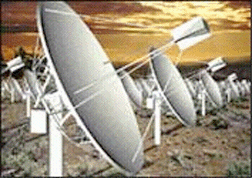![]()
|
A majority of the search for extraterrestrial life has been done through the use of radio telescopes. These very special telescopes detect waves that occur in the low-energy (or radio) end of the electromagnetic spectrum. The human eye cannot see radio waves because it does not have the ability to see energy waves as long as radio waves. These low energy waves are emitted by many cosmic sources such as stars and planets. Here on Earth we have several radio telescopes that are involved in extraterrestrial research. The Arecibo Telescope in Puerto Rico (shown at left) and the Parkes Telescope in New South Wales, Australia are two of the telescopes that participate in this research. At this time, though, no telescope is financially able to devote 100% of its time to search for life in other parts of the universe. That all may be about to change. |
Recently plans were announced to build the Allen Telescope Array (an artist's rendition of the Array is shown below). This telescope will be built in California's Cascade Mountains and will be a joint effort between the SETI (Search for Extraterrestrial Intelligence) Institute and the University of California, Berkeley. The telescope will cost approximately 26 million dollars and is being financed by Paul Allen and Nathan Myhrvold, both of whom experienced financial success at Microsoft. This telescope will be involved in SETI research 24 hours a day, 7 days a week.

A search for signs of life in other parts of the universe is done by looking at the radio emissions of individual star systems. Each star in the system is examined for possible planets that may be orbiting the star. An advantage of the newly proposed Allen Telescope is that it can look at more than one star at a time. The current radio telescopes are limited to searching only one star at any given moment. Another advantage of the Allen Telescope is that it is not going to be just one large bowl-shaped disk like the majority of radio telescopes currently in use, such as the Arecibo Telescope. Arecibo is one large disk that is 305 meters in width. The Allen Telescope will be a series of smaller bowl-shaped disks that are linked together. Anytime the scientists wish to enlarge the telescope all they have to do is add more disks. The Allen disks will contain antennas that are able to detect radio waves with frequencies from 1000 to 10,000 megahertz. The ability of scientists to continue to search for life in other worlds will be greatly enhanced by the addition of the Allen Telescope Array to our telescopic capabilities.
![]()
The StarChild site is a service of the High Energy Astrophysics Science Archive Research Center (HEASARC), within the Astrophysics Science Division (ASD) at NASA/ GSFC.
StarChild Authors: The StarChild Team
StarChild Graphics & Music: Acknowledgments
StarChild Project Leader: Dr. Laura A.
Whitlock
Curator:
Responsible NASA Official: